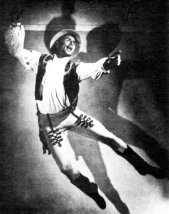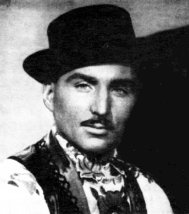|
Csaba Pálfi
|
|
CLICK AN IMAGE FOR LARGER VIEW
 Dr. Csaba Pálfi, from Budapest, Hungary, was a founding member of the Hungarian State Folklore Ensemble, and danced as a leading soloist for fifteen years. He received degrees in Ethnology and Ethnomusicology from the University of Budapest.
Dr. Csaba Pálfi, from Budapest, Hungary, was a founding member of the Hungarian State Folklore Ensemble, and danced as a leading soloist for fifteen years. He received degrees in Ethnology and Ethnomusicology from the University of Budapest.
Csaba became a professional folklore dance instructor, as well as a member of the Hungarian State Folklore Institute. He designed choreographies for performing groups in both Hungary and the United States. His teaching repertoire covered the entire spectrum of the lively Hungarian dance tradition, from the least difficult to the most complex.
Csaba toured the United States more than once in the dual capacity of instructor and performer, teaching many workshops such as the 10th International Folk Festival for the University of Chicago Folk Dancers in 1972. He also taught workshops in other countries, such as Australia and Japan. Rickey Holden collaborated with Csaba on his written dance descriptions.
He choreographed a Kalocsai Mars suite, which "depicts the gaiety of the Hungarian people as they respond to the surging gypsy rhythms," for the Brighan Young University International Folk Dancers. He also choreographed for a concert at the Glen Street Theatre in Belrose (a suburb of Sydney), Australia.
Csaba passed away September 24, 1983. He had complained of stomach cramps and was rushed to the hospital where he died during the operation.
Dances Csaba taught include Buzsáki Libegős és Kiopogós, Csillagtánc, Darudöbögös, Dunántúli Dus, Dunántúli Körverbunk, Erdélyi Legényes, Friss Magyar Csárdás, Gagybâtori Lippentős, Galgamenti Karikázó, Gubbantós Csárdás, Háromugros, Hódmezővásárhelyi Pálcástánc, Jászsági Csárdás, Juhásztánc, Kállai Kettős, Kalocsai Mars (with variations), Kalotaszegi Forgós, Kapuvári Csárdás, Kapuvári Verbunk, Karádi Kanásztánc (variations I, II, III), Karcsai Sarkantyús Csárdás, Körcsárdás (with variations), Kún Verbunk, Lassú Sergü, Magyar Csárdás I, Magyar Csárdás II és Verbunk, Marosszéki Forgatós, Palotás, Szatmári Csárdás, Szatmári Karikázó, Tüskümugrás, and Zöld Fű.
